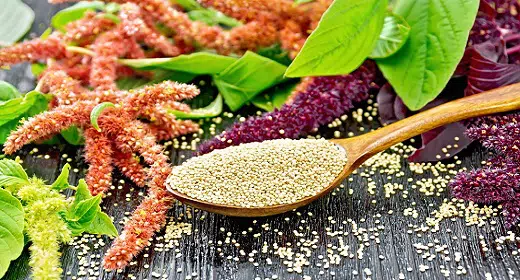by Ocean Robbins: The late comedian Mitch Hedberg observed that “Rice is great when you’re really hungry and want to eat 2,000 of something…
We are proud to announce a new partnership with John and Ocean Robbins and the Food Revolution to bring our readers Summits, Seminars and Masterclasses on health, nutrition and Earth-Conscious living.
Sign Up Today For the Healthy Brain Masterclass
” Had he known about amaranth, a tiny staple food about the size of a poppy seed, he might have amended the joke to “Amaranth is great when you’re really hungry and want to eat 100,000 of something.” And not just any something — amaranth delivers a powerful nutritional profile, has a distinctive, nutty flavor, and looks fabulous while growing.
If you prefer or need to avoid wheat, or just want to diversify your menu, amaranth is a gluten-free pseudocereal and falls into the same general category as other newly popular “ancient grains” such as quinoa, millet, and farro. Amaranth is easy to prepare and quite versatile, serving as a base for both sweet and savory dishes, so it might just become a staple in your kitchen as well.
If you’re new to amaranth, you might be wondering just what it tastes like, how to prepare it, and what kind of nutritional benefits it provides — as well as if there are any side effects to amaranth consumption. So let’s take a look at this tiny yet mighty whole food.
What Is Amaranth?

Amaranth is a grain that’s really a seed, so it’s technically known as a “pseudocereal” — a distinction that makes less and less sense every time I write about it. Fortunately, your taste buds and digestive system don’t care what you call it. All they’ll know is that amaranth is delicious and provides comprehensive nutritional benefits.
Like quinoa, amaranth contains no gluten and is considered a whole grain. These similarities aren’t coincidental — both pseudocereals are members of the Amaranthaceae family, which also includes beets, chard, and spinach. (With that much dietary diversity, they must hold some wild reunions.)
When it comes to quinoa vs amaranth — quinoa has a richly deserved reputation as a nutritional powerhouse, but amaranth holds its own in comparison. While quinoa has eight grams of protein per cup, amaranth has nine grams. And while quinoa has three grams of iron per cup, amaranth has five grams.
Visually, when you’re looking at a pile of amaranth, you’re seeing a heap of tiny, pale, golden or tan seeds, kind of like if someone made a movie called, Honey, I Shrunk the Seeds. But amaranth is about much more than seeds. Not only is it a healthy gluten-free alternative, both whole and as flour, but amaranth greens are also edible. And you can heat amaranth seeds, turning it into puffed amaranth — a crispy, nutty snack like popcorn (“poparanth,” anyone?). Plus, amaranth seeds can be also germinate for sprouts and microgreens.
What Does Amaranth Taste Like?
While quinoa is famously mild and uncomplainingly takes on the flavor of whatever it’s cooked with, amaranth has some definite ideas of its own. When cooked, the taste of amaranth has been described as “nutty” by fans, and — in the interest of full transparency — “grassy” by some who don’t like its flavor. You’ll have to try it and decide for yourself.
Amaranth Uses Around the World

Amaranth is a group of more than 60 distinct species of grains that humans have cultivated for about 8,000 years. Most of these species are native to Central and South America, where they traditionally served as staple crops for the Incan, Mayan, and Aztec civilizations. The Aztec, in particular, considered the amaranth plant sacred and made religious offerings not just of the seeds themselves, but also of sculptures of their deities made from honey and amaranth dough.
As a result, Spanish conquistadors banned the cultivation of amaranth, which they saw as an obstacle to the establishment of Catholicism in the Americas. But native farmers resisted and grew amaranth, saving amaranth seeds in secret despite severe penalties that sometimes included having their hands cut off.
The plant proved worthy of its name — in Greek, amaranth, or amarantos, means “unfading” or “inextinguishable.” To this day, indigenous activists still regard the growing of amaranth as an “act of resistance.”
Amaranth plays an important nutritional and cultural role around the world. Ethiopians use the seeds to make an unleavened bread called kita, an alcoholic beverage called tella, and fermented porridge known as borde, which nourishes new mothers and their babies. Amaranth also features in Indian (where it’s referred to as rajgira), Vietnamese, and Mexican cuisine, including the calaveras or “skulls” with raisin eyes and peanut noses traditionally eaten in Dia de los Muertos (Day of the Dead) celebrations.
Types of Amaranth
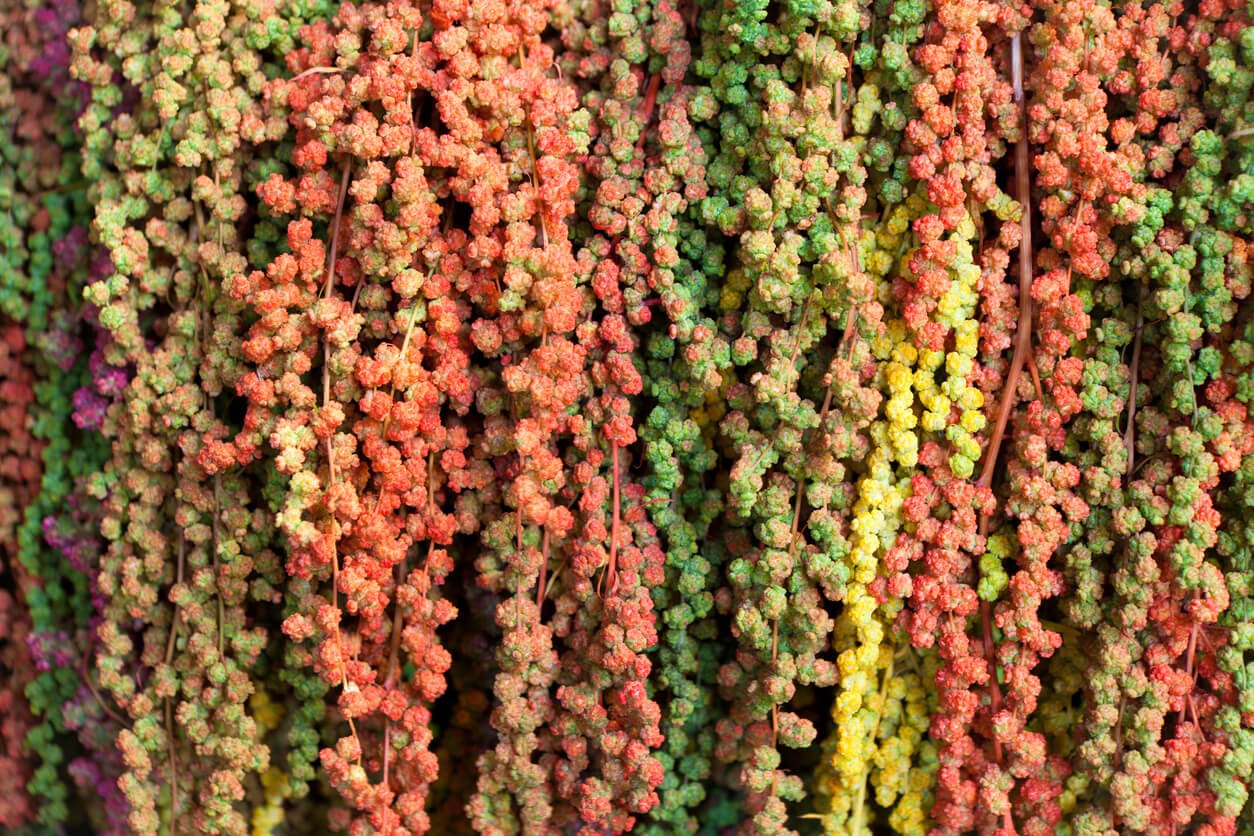
Many varieties of amaranth exist, some of which are grown for their seeds, some for their greens, and others for largely ornamental uses. You’ll probably find at least one of five common varieties of the grain in your local grocery store.
Amaranth types include:
- Red amaranth (Amaranthus cruentus), native to Guatemala and Mexico
- Foxtail amaranth, also known gruesomely, if poetically, as love-lies-bleeding (Amaranthus caudatus), native to Bolivia, Peru, and Ecuador
- Slim amaranth (Amaranthus hybridus), native to Eastern North America, Mexico, Central America, and northern South America
- Prince of Wales feather (Amaranthus hypochondriacus, which literally means “vigorous, upright plant” but sounds like the amaranth is constantly worried about wet rot or an infestation of pigweed weevil), native to Mexico
- Joseph’s coat (Amaranthus tricolor), native to tropical parts of Asia
Amaranth Nutrition

Amaranth is a rich source of the essential amino acid lysine, which can sometimes be challenging to get enough of on a plant-based diet. Other popular grains, such as corn and rice, are low in lysine, so adding amaranth to your diet — as well as quinoa and buckwheat — can help ensure that you get sufficient amounts. Symptoms of lysine deficiency can include frequent cold sores, high blood pressure, hair loss, and fatigue, so it’s a good nutrient to make friends with. In fact, amaranth is a complete protein, and has bragging rights for containing adequate amounts of all nine essential amino acids.
Aside from protein, amaranth is also a great source of many other important nutrients, including fiber, B vitamins, and vitamin E. It’s minerally rich as well, sharing with us important compounds like calcium, zinc, iron, magnesium, phosphorus, and manganese that the plant extracts from the soil. Amaranth appears to provide particularly bioavailable forms of calcium, zinc, and iron, making it a good choice for people who have difficulty keeping their levels up.
A half-cup of cooked amaranth seed also provides 2.5 grams of fiber. Researchers at Purdue University found that 78% of the fiber in amaranth is insoluble, which is the kind of fiber that keeps things running smoothly…
And for those lucky enough to have access to amaranth leaves, they are, like other dark leafy greens, nutrient-dense health superstars.
Health Benefits of Amaranth
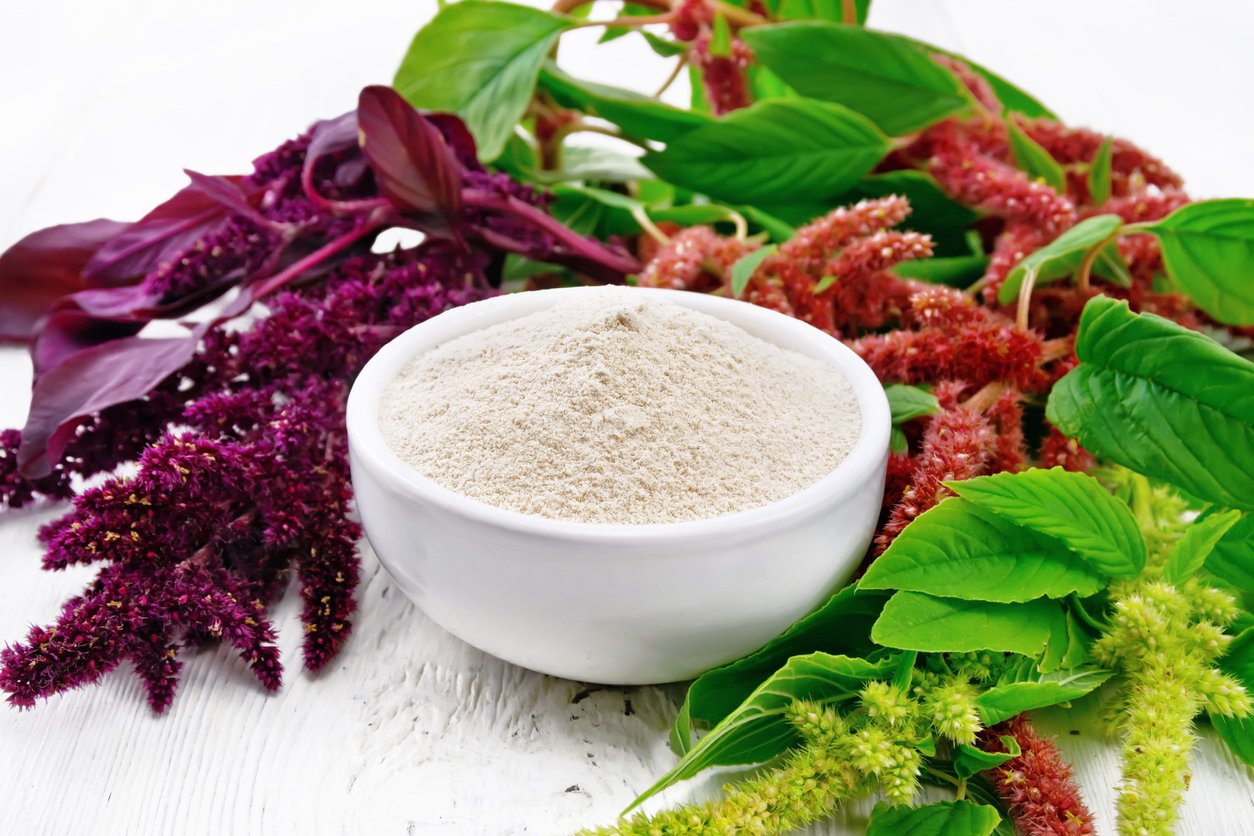
With all those nutrients in a protein- and fiber-rich, gluten-free package, amaranth can be a boon to your health. It’s a great alternative for those who are avoiding gluten (if you have Celiac disease, be sure to check for gluten-free certifications to ensure that there is no cross-contamination and there are no problematic traces of gluten in the amaranth).
1. May help with weight management.
Thanks to all that fiber and protein, amaranth can support healthy weight management by triggering satiety — which means that it helps you to feel full, and reduces the urge to overeat.
2. Could benefit heart health.
Amaranth may also support heart health. There’s a lot of evidence that consumption of whole grains and pseudocereals can reduce the risk of heart disease, and indeed, death from any cause. Amaranth, in particular, appears to be helpful in lowering LDL cholesterol.
In one animal study, hamsters were given a high-cholesterol diet supplemented by either nothing, amaranth oil, or amaranth grain. Those fed amaranth lowered their very-low-density LDL cholesterol (the “very bad cholesterol”) by up to 50% compared to controls. (Our view on the use of animals in medical research is here.)
3. Can help with inflammation.
Amaranth also possesses anti-inflammatory qualities, as was demonstrated by this 2014 study, which concluded: “Amaranth hydrolysates inhibited LPS-induced inflammation in human and mouse macrophages by preventing activation of NF-κB signaling.” Aren’t you glad that it’s my job to read these articles and just share the punch line with you.
4. Contains antioxidants important for disease prevention.
Amaranth is also rich in antioxidants such as phenolic compounds, which have been shown to reduce the risk of certain cancers and neurodegenerative diseases.
How you process and prepare the amaranth seems to matter. The highest antioxidant activity has been found in the amaranth seeds, compared to amaranth flour or popped grains. And while soaking amaranth may increase nutrient bioavailability and absorption, it appears to reduce amaranth’s antioxidant potential.
Other Amaranth Benefits
Amaranth is not just good for individuals, but potentially for the entire planet. Those tiny amaranth seeds produce huge yields. And the entire amaranth plant can be used in some way, from the seeds to the leaves to the sprouts and microgreens. Able to withstand droughts, heat, and most pests, amaranth can survive in terrain that most other high-calorie staple foods would find inhospitable. Some food activists actually view amaranth as a food that could help to feed the world in the face of climate change.
Potential Amaranth Side Effects & Downsides
Gastrointestinal Effects
As with any high-fiber food, amaranth can take some getting used to for folks who currently consume low-fiber diets. If you’re just transitioning to a plant-based diet full of unprocessed and lightly processed foods, avoid potential gastrointestinal distress by slowly adding to your diet. Eat a modest amount to start, and make sure you drink enough water to help the fiber flow through your system in a peaceful and loving manner.
Antinutrients in Amaranth
Amaranth contains so called “antinutrients” that may potentially inhibit the absorption of certain minerals. Some of these antinutrient compounds include oxalates and lectins, which are present in a wide variety of healthy plant foods, like grains, legumes, nuts, and seeds.
Since this is a topic of considerable controversy, I want to make it clear that for a variety of reasons, most people do not need to worry about avoiding or limiting these compounds in their diets. In fact, these so-called “antinutrients” offer health benefits themselves, which suggests that the label “antinutrient” is misleading. (For a full review of the research on these compounds, check out our articles on lectins and oxalates.)
Taste and Smell
Also, as I mentioned earlier, amaranth has a more potent aroma and taste than quinoa and other ancient grains, which may be off-putting for some people. Food is all about personal preference (and I would never judge you for not being a fan of amaranth), but give it a try, and let us know what you think.
Amaranth Uses

Pseudocereals like amaranth tend to be versatile since they can either be cooked and prepared in their whole form, or ground into flour to use in cooking and baking. And amaranth boasts a flavor profile that works well in both sweet and savory dishes.
How to Cook Amaranth
The simplest way to cook amaranth seeds is to simmer them in liquid, such as water or vegetable broth, like you would cook rice or quinoa. Amaranth cooks relatively quickly (roughly 20 minutes simmering on low heat, or just a few minutes in a pressure cooker). For a dry pilaf, add 1.5 cups of water to every cup of amaranth. Add savory ingredients like onions and garlic, mushrooms, and chopped veggies for a tasty and filling amaranth side dish.
For a wetter cereal or amaranth porridge, use 2.5 cups of water per cup of amaranth. Season it like oatmeal, with dried, fresh, or frozen fruit, cinnamon, raw nuts, and seeds.
Popped Amaranth
You can also “pop” amaranth by dry roasting or toasting seeds in a saucepan or wok. Just keep the heat low and shake the pan constantly so the tiny seeds don’t burn. And keep a lid on it, so the popping amaranth seeds don’t make an unintended visit to the floor. I’ve read that you can use an air popper, but I tried it once, and the results were disappointing. You won’t eat the popped amaranth as a snack like popcorn (they’re just too small — it would be like trying to stick handfuls of airy poppy seeds into your mouth). Instead, you can add the nutty, crispy grains to salads, morning porridges, plant-based yogurts, smoothie bowls, and desserts; mix them into energy balls; fold them into baked goods; or stir them into homemade or store-bought granola.
Sprouted Amaranth Seeds
You can also sprout amaranth seeds, which can reduce the concentrations of “antinutrients” like oxalates and lectins. To do this, rinse the grains, then cover in cool water and soak for 30 minutes. Rinse and drain the amaranth thoroughly 2–3 times per day. At room temperature (which is a pretty unspecific term; as comedian Steven Wright points out, “It doesn’t matter what temperature a room is, it’s always room temperature”), sprouts should begin to form within 2–4 days. One pound of seeds will yield around two pounds of sprouts.
Baking with Amaranth Flour
When baking with amaranth flour, limit the amount to a quarter of the total flour in the recipe. This is because amaranth flour is heavy (though flavorful) and can cause the final product to become very dense. Try combining amaranth flour with another flour, like organic oat, millet, whole wheat, or almond flour — or using it as a thickening agent in soups and creamy sauces. You can also use amaranth flour as a breading or coating for tofu or avocado wedges before cooking.
Where to Find Amaranth & How to Store It
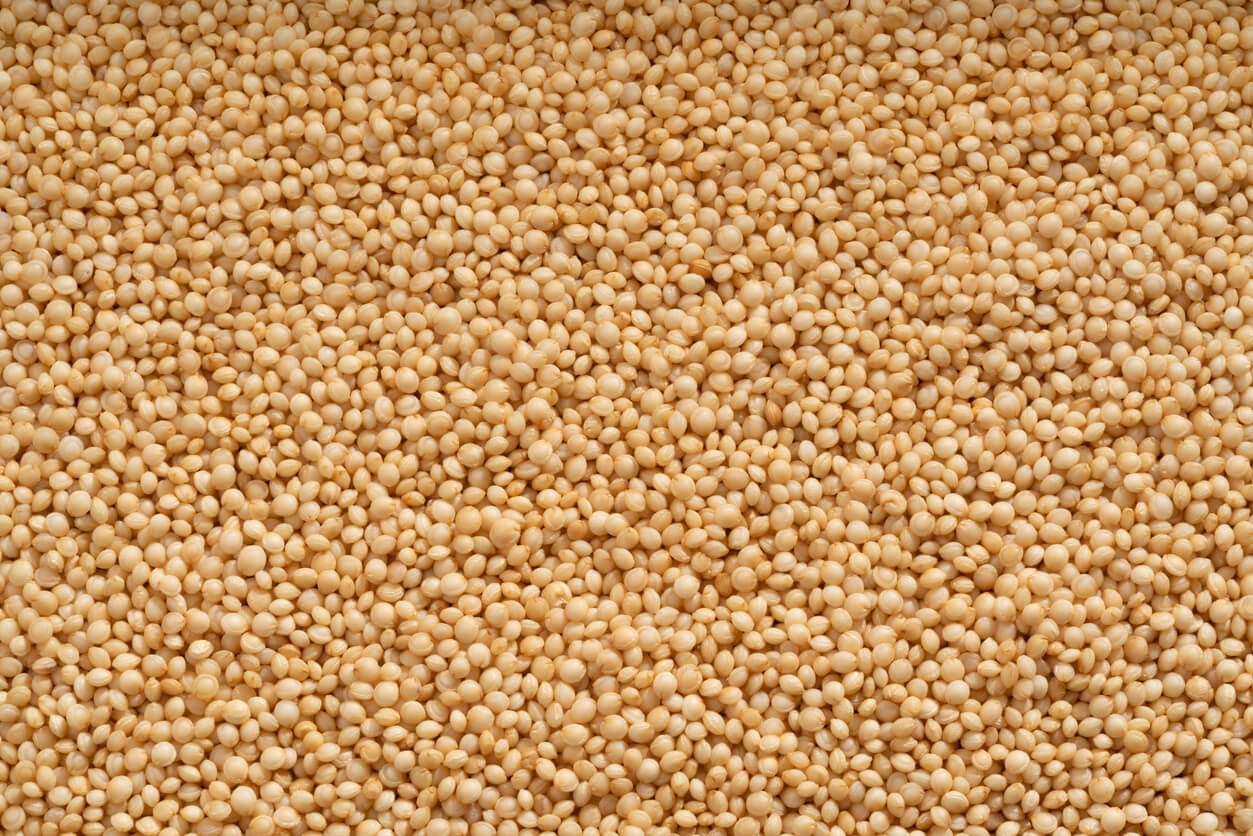
You can find amaranth and amaranth flour in many grocery stores, often in the “health-food” section (if one section is for “health food,” what does that say about the rest of the store?), and can also be purchased from various online retailers (like this one). It’s usually sold in bags of one, five, or 10 pounds, as well as in bulk. If you want to be sure to avoid potential exposure to glyphosate, which is sprayed on some crops before harvest to dry them out, opt for organic amaranth products.
To store amaranth, keep it in an airtight container (or the closed plastic bag that it came in) in a cool place, away from bright light to prevent it from going rancid. Kept correctly, whole uncooked amaranth can last up to four months in the pantry or eight months in the freezer. Amaranth flour will stay fresh in the pantry for 2–3 months and in the freezer for up to six months.
How to Grow Amaranth
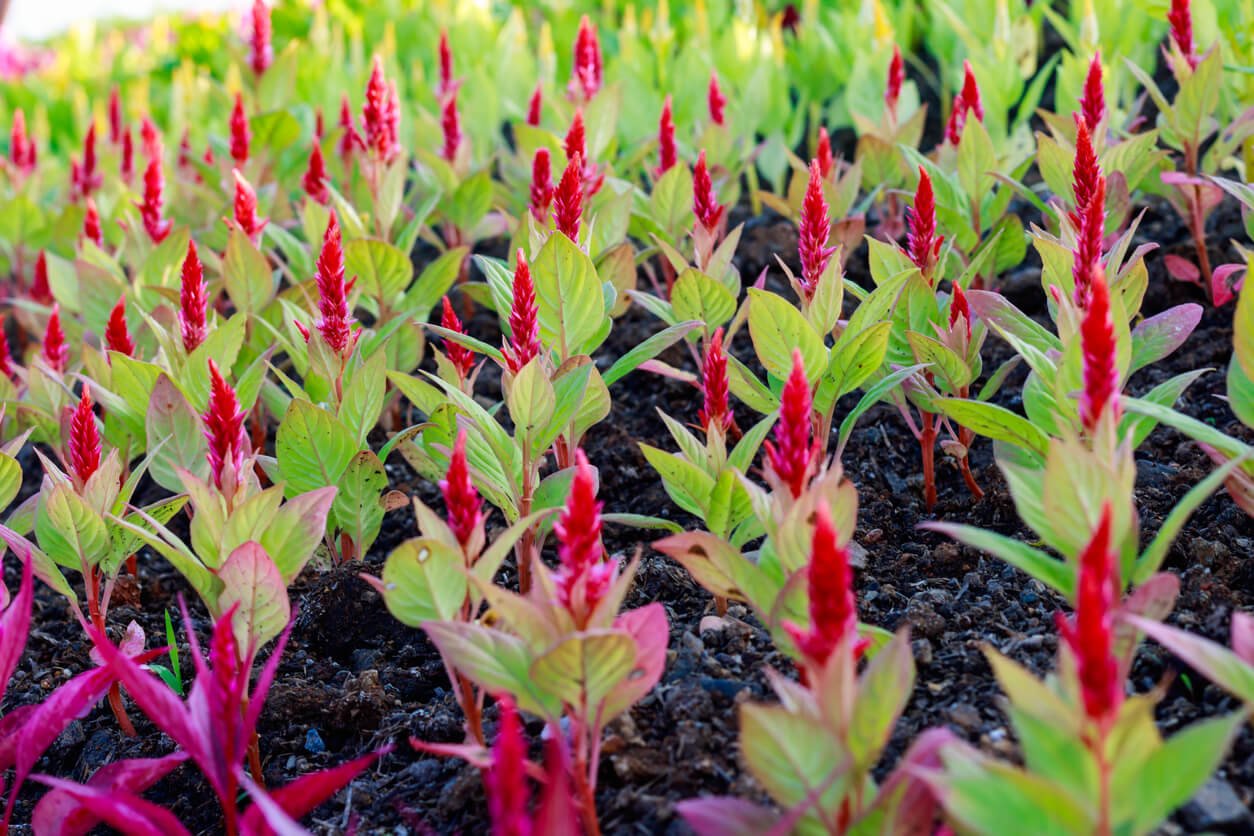
Because amaranth plants are so hardy, environmentally friendly, and beautiful, I would be remiss if I didn’t encourage you to grow amaranth in your garden — if you’re in a hardiness zone between 2 and 11. Some varieties grow up to eight feet tall, which would be great if you wanted to create an amaranth maze for Halloween. But the veggie and seed varieties reach only 3–4 feet high and may be more manageable for a home garden. The Organic Hopi Red Dye variety is a great option if you want to eat the seeds, microgreens, and leaves (and/or do a little dyeing, as well).
Plant your amaranth seeds in full sun 4–6 weeks after the last frost date, as amaranth plants do best in warmer and moister soil. Don’t overwater them (no more than an inch of water per week, including rain) to avoid root rot or fungal diseases. You can thin the small plants after two weeks and use them as microgreens. After six weeks you can harvest the amaranth leaves, which you can eat and use like spinach and chard.
Visit your amaranth bed frequently to enjoy the riotous colors of the flowers — red, burgundy, pink, orange, or green, depending on the variety.
You can start harvesting the seeds after 3–4 months. Simply cut off the flower heads and let them dry in the sun. Once dry, put them into a deep dish and crush them using a rolling pin or your hands to make the seeds pop out. To separate the grassy chaff from the seeds, use a hair dryer on the cool (no heat) and low-airflow settings. A single amaranth plant can produce half a million seeds, which sounds pretty impressive — although it is actually just about two pounds worth.
Downsides to Growing Amaranth
Not all is love and light in the relationship between amaranth and gardeners, however. There’s a variety of amaranth known unflatteringly as pigweed, which grows tall, with a deep taproot, as a yard weed. You may not want or like it, but you kind of have to admire its spirit and tenacity, especially its resistance to the dangerous Bayer-Monsanto herbicide, glyphosate.
Another concern for gardeners who aren’t ready to commit to amaranth — the plants will readily self-seed, which means that the crop you planted last year may very well reappear this spring, despite your desire to plant something different in that bed. With all those millions of seeds, you’re bound to drop a few thousand (if not a few billion!) into the soil.
Amaranth Recipes
Are you inspired to experiment with this nutrient-dense ancient grain? Next time you’re in the grocery store or online, look for whole amaranth, amaranth flour, or puffed amaranth — or all three! — and start having fun with the recipes below.
Apple Pie Porridge replaces traditional oatmeal with a combination of amaranth and teff to make a delicious, rich porridge that is reminiscent of — you guessed it — apple pie! Pumpkin Spice and Amaranth Smoothie Bowl is perfect for cooler months with its warming spices, though it can certainly be enjoyed year-round. And finally, get your (clean) hands dirty by diving into the Amaranth Potato Paratha, a traditional Indian bread that is both good for you and gluten-free.
1. Apple Pie Porridge
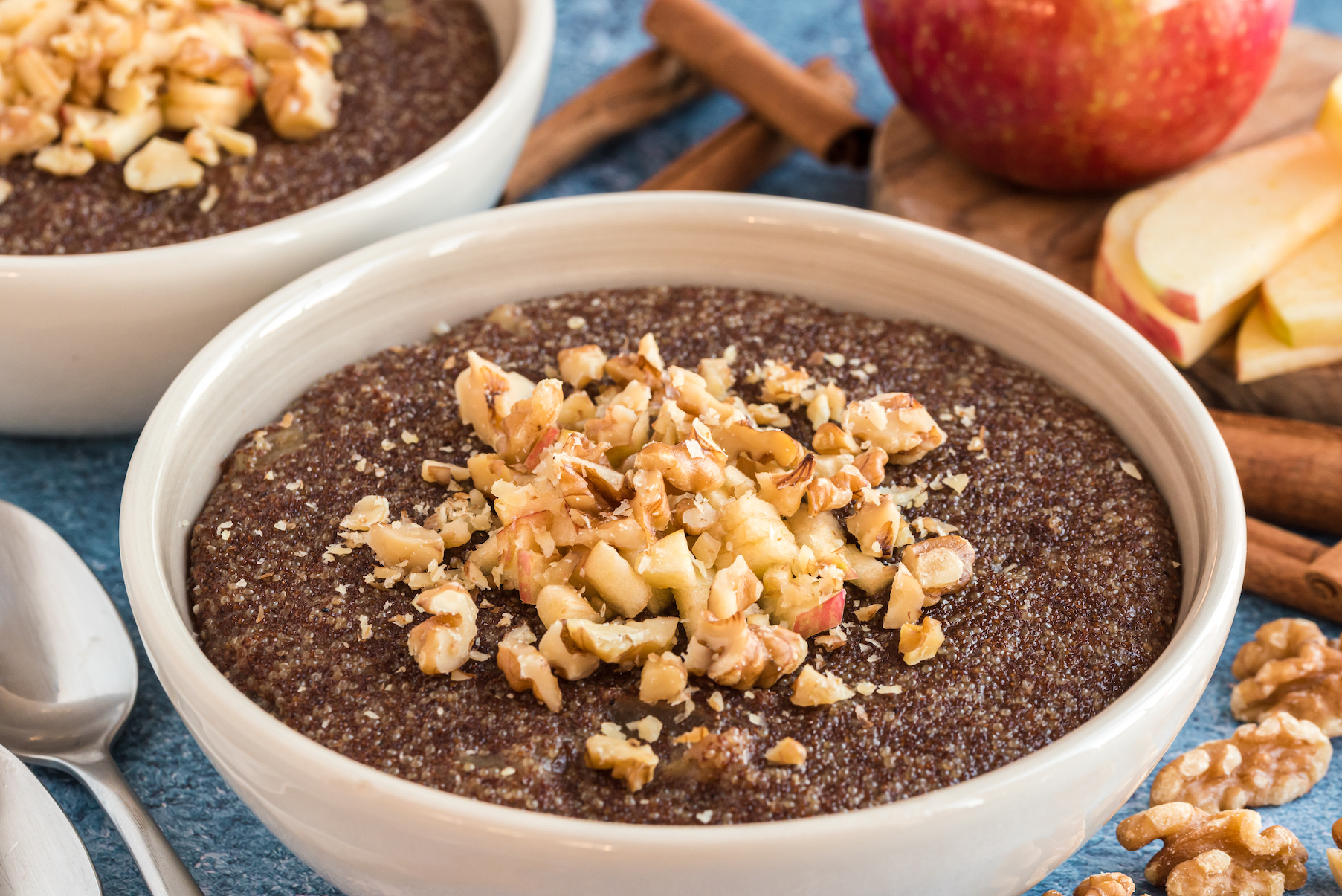
Picture this — a delightful apple pie aroma captivates your senses and gently nudges you in the morning as you move to start the day. And all you need to do is walk into the kitchen to serve yourself a bowl of this comforting and nourishing breakfast. It’s waiting for you because you prepped it the night before! Amaranth and teff take the place of oats to add variety and inspiration to your recipe repertoire. Enjoy all their nutty flavors, nutrition, and fun texture to start your day.
2. Pumpkin Spice and Amaranth Smoothie Bowl
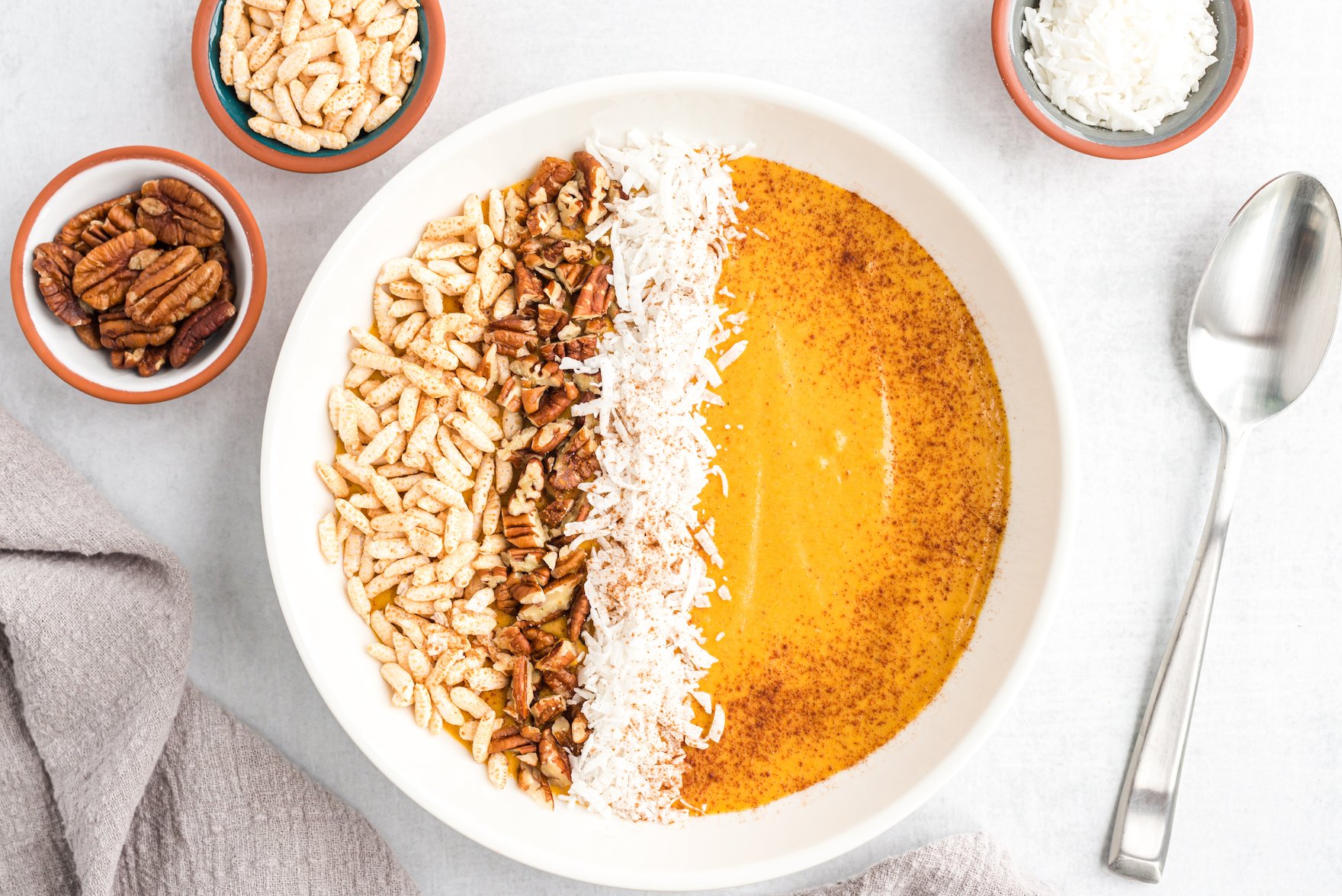
Fruit doesn’t have to be the only star in a smoothie bowl. Vegetables and grains deserve their chance to shine, too! As you now know, gluten-free amaranth ranks as one of the highest protein-containing grains. And while smoothie bowl could be a perfect choice for the fall season, you can certainly enjoy the nutrients, textures, and flavors that amaranth and pumpkin offer year-round.
3. Amaranth Potato Paratha
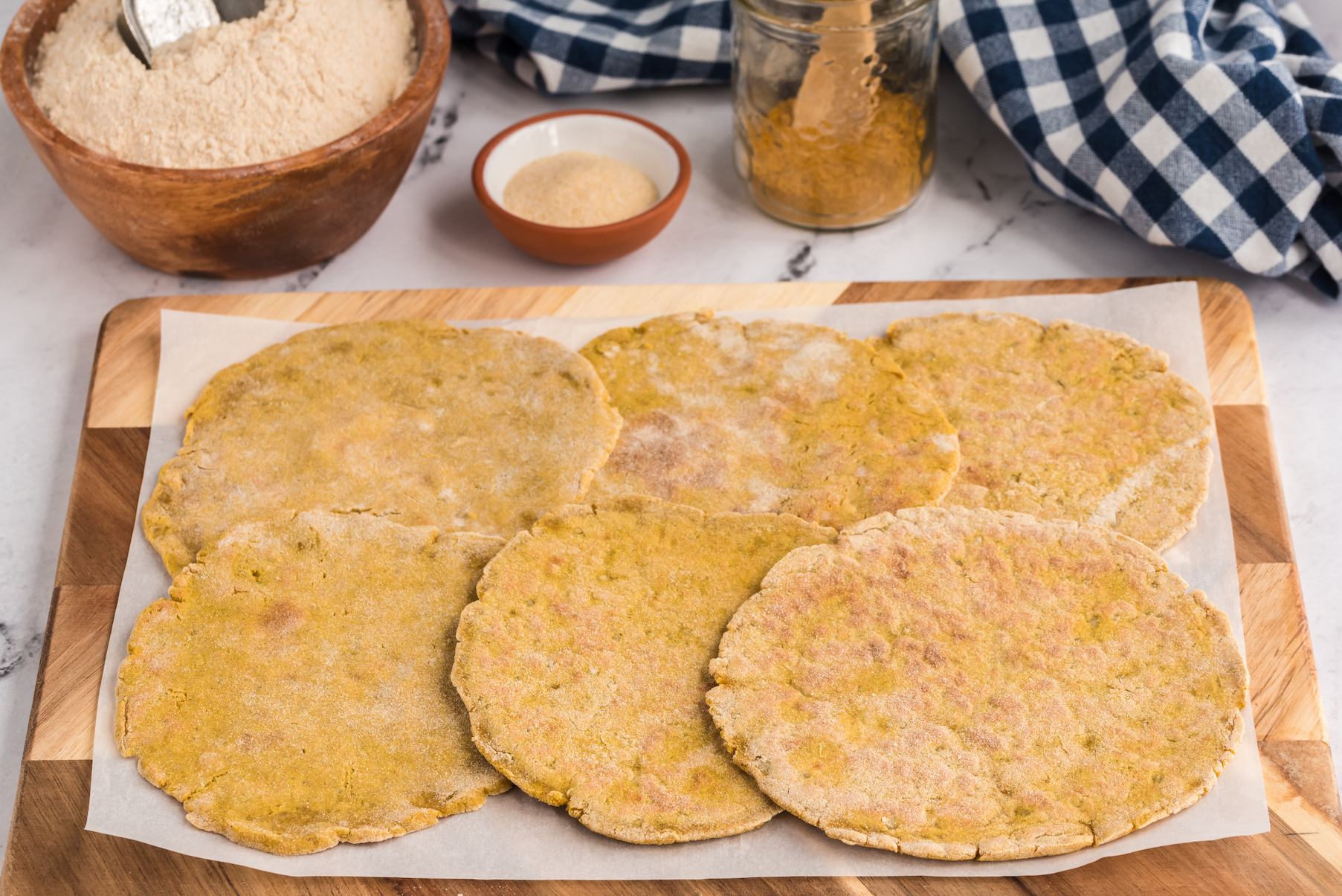
Dine-in but feel like you’re dining out with this homemade Indian paratha bread made with whole-grain amaranth flour and potatoes. Amaranth flour is commonly used in Indian cuisine not only for its nutritional value but also because it’s gluten-free — and amaranth is ideal for all bread lovers. Pair the paratha with your favorite Indian dishes like Chana Masala or Bhindi Masala.
Amaranth Is a Unique & Nutritious Grain
Amaranth is a unique pseudocereal with a rich history and, hopefully, a great future. Don’t let its size fool you though — the tiny seeds are packed with nutrients and full of flavor. It can be used in both sweet and savory dishes, ranging from breakfast porridge to thick stews or even puffed kernels. Amaranth can also be ground into a flour for nutritious, gluten-free baking. While you’ll probably only find one variety of amaranth in your local grocery store, you can source other varieties online, and maybe even grow your own. If you enjoy other ancient grains and seeds, consider adding amaranth to your rotation.







